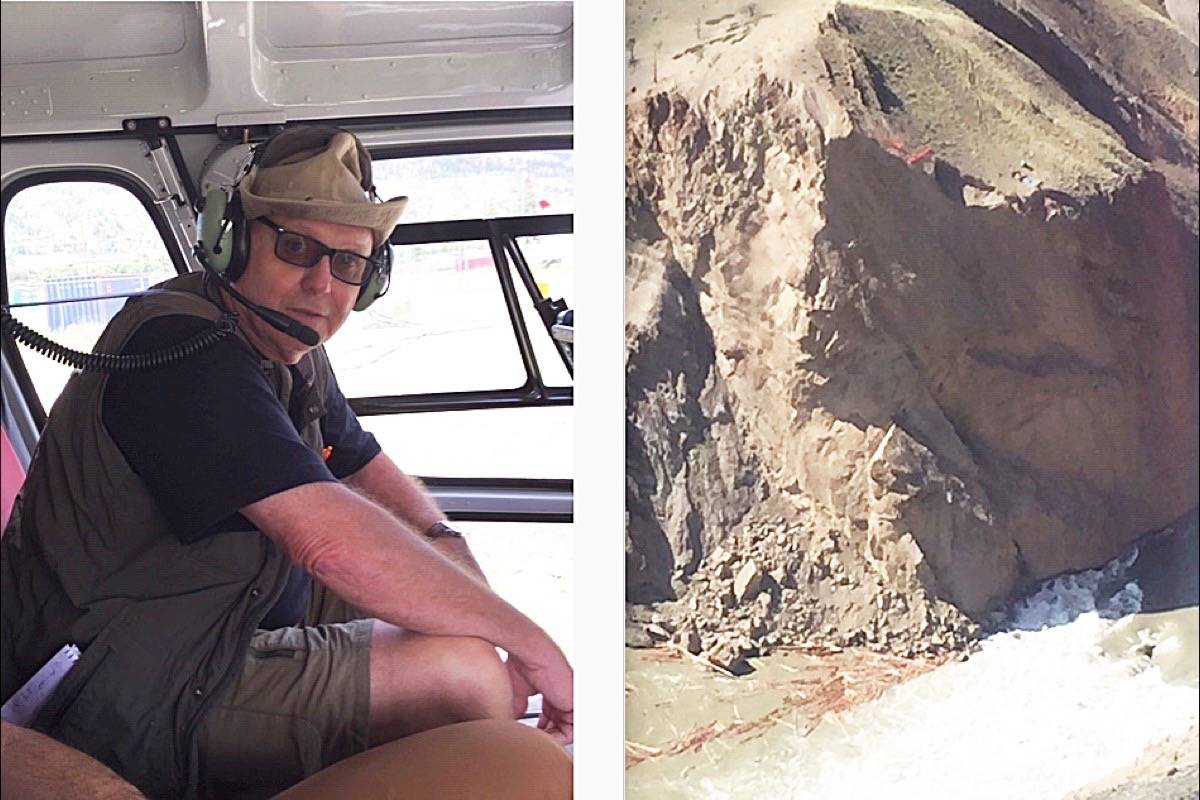“My prayers for the struggling salmon flowed like tears as the offering washed through my fingers into the river of life.” Greg Witzky.
The Big Bar Landslide Incident Command Team in Lillooet is leading an unprecedented salmon rescue operation in the Fraser River. In November, a landslide debris created a five-metre-waterfall north of here in the Fraser River. Turbulent, fast-moving water is preventing fish from moving upstream to where they can spawn.
In early July – when work began to get them past the blockage, 40,000 Stuart chinook salmon were already backed up, bound for some of the 56 northern streams and lakes.
Al Magnan, of DFO, is unit environmental leader for the federal government. “We have not detected any fish passing the slide,” he said in Lillooet, July 27. I was there for a media briefing in the command centre offices.
Witzky, incident commander for First Nations, brings indigenous knowledge and experience to the team. He’s happy about its collaborative function.
Incident Command is represented by the B.C. Forests, Lands and Natural Resources ministry, the federal government, and First Nations leaders. “We’ve been told we have a decision-making role this time,” says Witzky. “We’re not just talking about it.”
Witzky’s consulted local First Nations elders for guidance in his participation. “They said respect nature and take care of us,” he tells me. “Protecting the salmon is our first law.”
The Incident Team includes Kevin Skrepnek of BC Wildfire Service. He said media could view the slide by helicopter if weather permits and wildfires don’t break out.
The primary aim of work here since early July has been to make salmon migration upstream possible again. Rock climbers trained in detonation will strategically drop boulders – some five metres high – into the river to create a series of pools and back-eddies; a natural fish ladder.
But efforts have been delayed by rain and thunderstorms. Flooding in the Chilcotin area increased water flow downstream. Dozens of 12-metre logs collect near the waterfall. They’re a safety issue for boat crews. Finally, loose debris on the 123-metre-high cliff is dangerous. It has to be scaled off before boulders can be positioned.
The early chinook wait. This species has been labelled endangered by the Committee on the Status of Endangered Wildlife.
The Fraser’s seven chinook runs – bound for the Stuart Lake system near Fort St. John – should have moved up by now. They could die without spawning.
A July 12 DFO media update states, they’re “critical to the future sustainability of these salmon, and to the economic livelihood of many who depend on these stocks.” These include 50 First Nations groups.
Then, there’s the sockeye.
The Fraser is the largest producer of sockeye in the world (100 stocks). Two-thirds are destined for the lakes and streams north. The Quesnel and Chilko system fish are the largest group. Early Stuart sockeye – the first run – were expected mid-July.
Following those are Interior Fraser steelhead (chilcotin), spring/summer chinook, pinks, and Interior sockeye. Northern sockeye represents half of the river’s commercial catch. They’re important to recreational fishers, and to orca whales.
If this year’s fish can’t spawn, then returns in the following three to five years will be dismal. Some chinook and sockeye have been trucked to Cultus Lake for egg-takes. It’s hoped fry released next year may help preserve some of the stock.
There’s all-out effort to save salmon by engineers, biologists, seine netters, and rock-scaling acrobats who start work at 7 a.m. and finish at 7 p.m. Hours may be extended.
They look like ants from the Blackcomb helicopter. Johann, the pilot, points out segments of prefabricated ladder at the water’s edge, and fish holding tanks.
By July 27, only about 500 fish had been moved upstream.
On Aug. 13, the total was “9,543 sockeye and 2,844 chinook.” Estimates are 2.5 million fish will arrive.
As of Tuesday, no fish are getting up by ladder. It’s not ready.
In Lillooet, on July 27, incident team members praised the public for helping out. The Big Bar Ferry – used to transport equipment – offered to extend work hours. A local bakery stays open later.Private contractors offer strategies to complement a fish wheel, beach seines, and dip nets.
B.C. folk love our wild salmon.
The slide occurred in November, but it was only reported June 23. During a media conference call, Aug. 6, Fisheries Minister Jonathan Wilkinson was asked why Fisheries didn’t notice it earlier.
He replied, “It was found in accordance when we’d expect to find something like that. We don’t necessarily go up and down the river every six months doing inspections.”
Could delays assessing strategies, organizing work crews, readying the pre-fab ladder, have been shortened if the river was inspected all year? It’s a valuable resource. Witzky says protecting the salmon is a First Nations law. That’s the right thinking and regular monitoring would support it.
– Jack Emberly is a retired teacher, local author and environmentalist.
